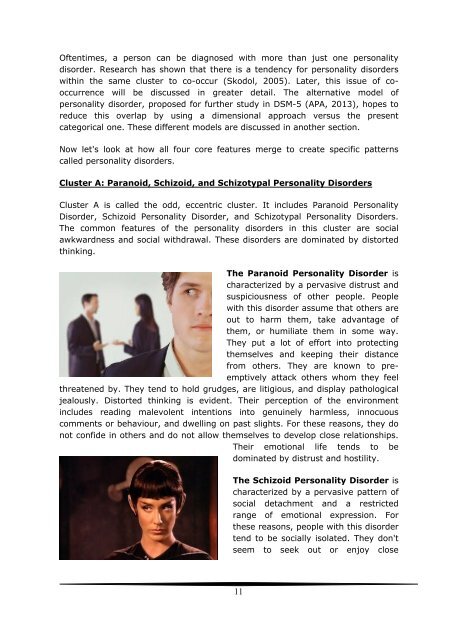personality disorders explained
Antisocial Personality Disorder, Codependence, Narcissism and Borderline
Antisocial Personality Disorder, Codependence, Narcissism and Borderline
Create successful ePaper yourself
Turn your PDF publications into a flip-book with our unique Google optimized e-Paper software.
Oftentimes, a person can be diagnosed with more than just one <strong>personality</strong><br />
disorder. Research has shown that there is a tendency for <strong>personality</strong> <strong>disorders</strong><br />
within the same cluster to co-occur (Skodol, 2005). Later, this issue of cooccurrence<br />
will be discussed in greater detail. The alternative model of<br />
<strong>personality</strong> disorder, proposed for further study in DSM-5 (APA, 2013), hopes to<br />
reduce this overlap by using a dimensional approach versus the present<br />
categorical one. These different models are discussed in another section.<br />
Now let's look at how all four core features merge to create specific patterns<br />
called <strong>personality</strong> <strong>disorders</strong>.<br />
Cluster A: Paranoid, Schizoid, and Schizotypal Personality Disorders<br />
Cluster A is called the odd, eccentric cluster. It includes Paranoid Personality<br />
Disorder, Schizoid Personality Disorder, and Schizotypal Personality Disorders.<br />
The common features of the <strong>personality</strong> <strong>disorders</strong> in this cluster are social<br />
awkwardness and social withdrawal. These <strong>disorders</strong> are dominated by distorted<br />
thinking.<br />
The Paranoid Personality Disorder is<br />
characterized by a pervasive distrust and<br />
suspiciousness of other people. People<br />
with this disorder assume that others are<br />
out to harm them, take advantage of<br />
them, or humiliate them in some way.<br />
They put a lot of effort into protecting<br />
themselves and keeping their distance<br />
from others. They are known to preemptively<br />
attack others whom they feel<br />
threatened by. They tend to hold grudges, are litigious, and display pathological<br />
jealously. Distorted thinking is evident. Their perception of the environment<br />
includes reading malevolent intentions into genuinely harmless, innocuous<br />
comments or behaviour, and dwelling on past slights. For these reasons, they do<br />
not confide in others and do not allow themselves to develop close relationships.<br />
Their emotional life tends to be<br />
dominated by distrust and hostility.<br />
The Schizoid Personality Disorder is<br />
characterized by a pervasive pattern of<br />
social detachment and a restricted<br />
range of emotional expression. For<br />
these reasons, people with this disorder<br />
tend to be socially isolated. They don't<br />
seem to seek out or enjoy close<br />
11

















